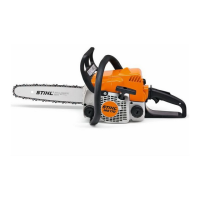
Do you have a question about the Stihl MS 18 and is the answer not in the manual?
Always wear gloves when handling saw chain to protect hands from cutters.
Pull chain from top; should rotate freely with no slack when brake is disengaged.
Pull chain at center; bottom drive link should just clear bar groove.
Chain stops/locks when hand guard is pushed or via inertia in kickback.
Place saw on ground, firm footing, check chain clearance.
Put right foot into rear handle, press down firmly.
Hold rear handle between legs, pull starter grip slowly then pull strongly.
Guide starter grip slowly back into housing to prevent rope damage.
When engine starts (false start), move lever to #2 (choke open), pull rope again.
Leaving saw in fast idle with brake engaged can overheat clutch/brake components.
Never run engine at full throttle without load for more than a few seconds.
Use systematic approach to identify and address all present faults for quick diagnosis.
Squeeze throttle fully open; actuate lever to full choke, then release throttle.
Actuate handle back/forth; an audible 'click' should be heard.
In the forward position, the sprocket must not turn.
In the back position, the sprocket must spin easily.
Pull rope to full length; ensure it is not about to break at the very end.
1130 saws lack mixture screws/limiter caps; H/L holes are blocked internally.
Only adjustment is idle speed screw; affects mixture slightly.
Connect tester, pull rope as if starting; if no spark, try new plug.
If no spark with new plug, disconnect ground wire from ignition module and re-test.
No spark implies faulty module; spark implies faulty stop circuit.
Place lever in OFF, pull rope; verify no spark is present.
Tests ring sealing with flywheel blocked; not typically necessary.
Always done on four-stroke as piston/rings aren't visually observable.
Leak down test also verifies intake and exhaust valves are sealing properly.
Pour fuel into pan; check for trash, debris, or contaminants like water.
Backflow filter with pressure pump to verify it is not restricted.
Hook tester, pump tester; no pressure should build; wet filter should flow fuel.
Plug one end of fuel line and test through the other; should hold steady at 10 PSI.
Line is OK if it holds steady; carb also passes if line holds pressure.
If gauge doesn't hold, isolate fuel line and test separately to find fault.
Plug one end of fuel line and test through the other; should hold steady at 10 PSI.
Ensure tank is empty before applying pressure.
Test verifies tank has no leaks (grommet, seam, cap, hose); apply ~8 PSI max.
Pump to see negative pressure; needle should move back to zero rapidly.
If needle doesn't leak back to zero quickly, replace tank vent and re-test.
Indicates lack of lubrication, dirt ingestion, or other running problems.
Remove sealing ring, use adapter, connect tester to impulse port.
Rotate flywheel; needle bounce indicates impulse signal is present.
Two-stroke needs airtight crankcase; test for leaks at gaskets, seals.
Pull 0.5 bar vacuum; should hold steady or not leak back to 0.3 bar within 20 seconds.
Rotate crankshaft under vacuum; verify seals are holding properly.
Pump 0.5 bar pressure into engine; should hold steady for at least 20 seconds.
Check sealing plate, spark plug with soapy water if failing pressure test.
